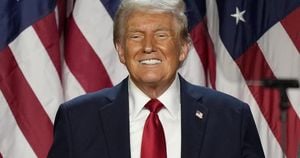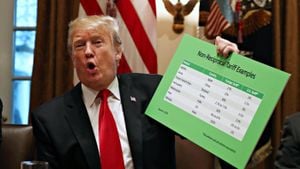With the 2024 U.S. Presidential Election heating up, economic policies have taken center stage, shaping the discourse among candidates and voters alike. The leading contenders, President Joe Biden and former President Donald Trump, are presenting distinctly different visions for the economy, which could have significant ramifications on the electorate's choice this November.
Since his inauguration, Biden has leaned heavily on what has been dubbed 'Bidenomics,' aimed at promoting growth through government investment and traditional Democratic principles. This strategy focuses on rebuilding the infrastructure, addressing supply chain issues, and boosting manufacturing jobs aimed at reducing inflation and catalyzing economic recovery following the pandemic. Economists note some success: the unemployment rate has dropped, wages have seen modest increases, and inflation rates have eased from their peak levels. Yet critics argue these measures fail to address the underlying issues faced by many ordinary Americans, including rising living costs and housing affordability.
On the other hand, Trump’s approach harkens back to his previous presidency, during which he emphasized deregulation and tax cuts as tools for stimulating economic growth. His plan posits the elimination of various regulations, potentially unleashing what he terms “burdensome rules” hindering businesses. Trump suggests tax breaks for middle-class families and increased military spending, expecting these measures will bolster both middle-class prosperity and national security. Notably, Trump has openly criticized Biden’s policies, claiming they lead to inflation and higher energy costs, appealing to frustrated voters seeking change.
While Biden faces backlash for inflation—significant increases were particularly noted for gas and food—he continues to maintain the narrative of economic resilience, projecting optimism for the economy’s future. Biden pointed to the recent job growth and spending capacity of the American worker as signs of the administration’s progress, reminding voters about expanded infrastructure investments and the importance of sustaining this momentum.
With just days until voting begins, both candidates have stepped up their campaign rhetoric, drawing lines not only on policy issues but how these policies affect the American people's lives. Trump has saturated the airwaves with messages asserting, “We were truly energy-independent; now we're begging for oil.” This resonates with voters directly impacted by energy prices, invoking the challenges they faced at the pumps under current leadership.
Financial markets are reacting to these election dynamics, analysts say. Stock futures have been susceptible to fluctuations stemming from polling data and expectations about forthcoming policies. Many investors are particularly sensitive to inflation concerns and the potential for increased interest rates, which could hamper growth. This environment creates uncertainty for voters worried about their financial futures, as evidenced by the stocks trading lower ahead of the election day.
This election seems to be shaping up as not just about who can lead but who can effectively improve the lives of average citizens struggling with day-to-day financial realities. Public opinion polls reflect this sentiment, with many respondents citing the economy as their top concern, indicating they are actively viewing the policies being pitched by both candidates.
Both campaigns are targeting their pitches based on these sentiments, making clear their visions for the economy. Biden stresses government intervention as necessary for supporting economic recovery, particularly amid signs of potential recession. Trump counteracts this by promising less government and promoting free-market dynamics as the path to prosperity.
Political analysts suggest how the candidates choose to frame these debates could result critically for their campaigns. For Biden, emphasizing the growing workforce and job creation might resonate more with suburban voters concerned about job stability. Conversely, for Trump, tapping back onto sentiments of patriotism along with economic self-sufficiency could pluck the strings of his base, particularly for those disheartened by job losses during the pandemic.
Meanwhile, independent candidates and third-party movements, though often underestimated, are gaining traction, capturing disillusioned voters who feel unrepresented by the two-party system. Some economists predict this could lead to unexpected outcomes within local and national races as these groups tap dissatisfaction with the mainstream narratives. Vigorous debates over healthcare, housing, and educational spending continue to capture the attention of voters who want tangible changes supported by real policies rather than just political rhetoric.
At the grassroots level, community organizers and local activist groups are raising awareness on specific policies, emphasizing the need for affordable healthcare systems and support for local small businesses. These organizations often rally votes by spotlighting the impact of national policies on local economies, particularly those rejuvenated following decades of neglect. Many voters, especially young ones, take to social media platforms to express frustration over perceived failures of both Trump and Biden to deliver transformative change to policies affecting them.
Looking at polling numbers, the race remains tight, with key battleground states holding significant sway over the chances of either candidate. Analysts urge attention to Midwest voters, especially those situationally reliant on manufacturing jobs, who are observing economic policies closely. Shifts here may easily tip the electoral balance and determine which candidate voters can trust to handle the economy more adeptly.
Election Day approaches rapidly, and as candidates make their final pitches, voters are encouraged to weigh the economic realities they face against the future these candidates are presenting. To them, feelings of frustration or hope can lead to decisions made at the ballots, whether they align with the bid for Bidenomics or desire to boldly unfurl Trumpian economic policies once again.



